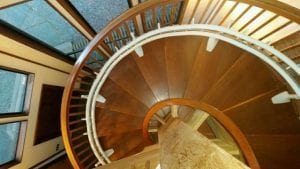Stair Lifts San Francisco
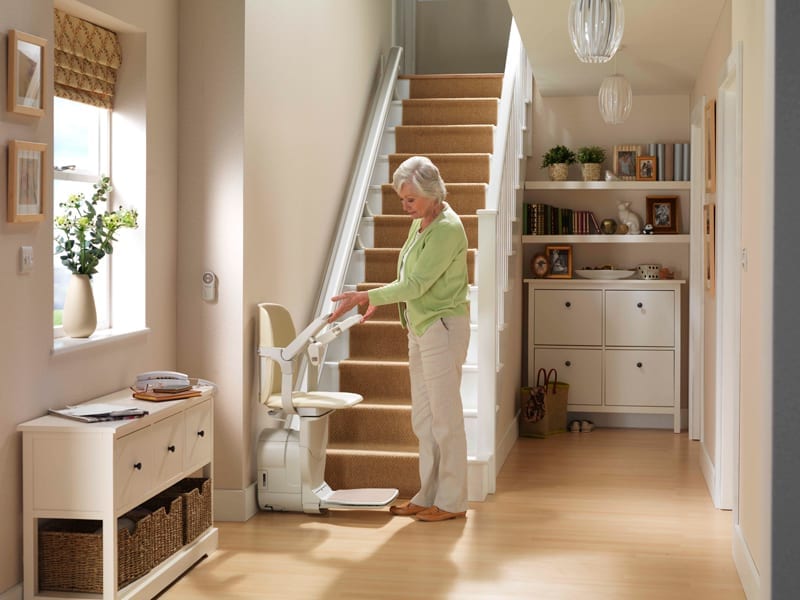
The unlimited variety of stair designs can pose a problem for some of the stair lifts San Francisco would have need of, but not here. ACME can install stair lifts in any stairway due to the different stair lift models offered. Some features available to all of the models include a quality swivel seat, a track built to fit the stairs instead of the wall, and a rigorous testing process. We are first and foremost concerned with you and your loved one’s safety. All our stair lifts come with multiple safety sensors on the chair, carriage and foot rest. That way, if something where to drop in front of the chair while it was traveling, it would stop immediately. . The previously mentioned testing process puts the stair lifts to their limits and ensures that the chairs will produce quality results for years to come. ACME makes stair lifts San Francisco can be proud of.
Curved Stair Lifts
The curved stair lifts have a few unique features that put their quality above and beyond the average product. One notable feature is the way the track is installed. Many of the curved stair lifts San Francisco has access to are fitted together on site and in most cases will not fit tight to the wall. Our rails are made specifically for your stairs so the stair lift takes up less space and operates much smoother. Another factor of installation is where the stair lift is parked. Different parking options are good to keep under consideration; these options can put the stair lift in a location out of the way of those who regularly walk the stairs, as well as distancing it from the top of the stairs in consideration of safety.
Safety and support are strong concerns here at ACME, Inc. While we pride ourselves on our stair lifts, San Francisco also has the support and emergency help that’s just a phone call away. Also, both the outdoor and straight stair lifts have tracks that contain tough copper strips that are always trickle charging the stair lift battery, so losing power won’t be a problem.
All in all, we know that our customers will feel at home with their top of the line stair lifts. San Francisco can rest assured knowing that it’s being provided top quality service and products by ACME, Inc.
To get an idea on costs, check out this information here.
Give Us a Call at 1-800-888-5267 or fill out our form and we’ll get right back to you!
Offering Stannah Stair Lifts to the San Francisco Bay Area

ACME Home Elevator has been awarded the Double Diamond Award by Stannah. The award is only given to a stairlift company with exemplary Performance and Customer Service. The Stannah family have been making lifts of all types for over 140 years. In 1975, they turned their attention to designing and manufacturing stairlifts and now sell them in more than 40 countries world wide. In 2011, Stannah produced their 500,000th lift. Stannah makes the best quality stair lift and is a company that you can rely upon.
Stair lifts San Francisco Quick Facts
We offer stair lifts for narrow stairs for you and for other stair users. Here in San Francisco, we can sometimes have some tight stair wells. That's ok! We can make the rail fit and curve around just about any set of stairs. Our stair lifts work on ANY type of curved stair way. Our curved model is the most versatile "stair chair lift" available for narrow, curved stairs. It can work around bends. It can go on either side of the staircase and negotiate intermediate landings and corridors easily. Your rail will be manufactured to the exactly for your staircase not assembled with off-the-shelf, pre-manufactured bent pieces. The two-way powered swivel option enables you to swivel the chair to the safest position at both the top and bottom of the stairs, particularly in tight spaces. Our stair lifts are installed in just half a day. Because our stair lifts are attached to the stairs, not the wall, the process is quick, clean and simple. Our friendly installers will work with minimum fuss, tidy up afterwards, test the stair lift thoroughly and show you exactly how to use it before they leave. Our lifts work during a power outage. We all know here in San Francisco that we sometimes lose power. Brown outs can happen here in the Bay Area. Our stairlifts are battery powered so it continues to work even if your home loses power. Commitment to Safety and Reliability ACME Home Elevator's owner, Wes Rockhold, is a member of the ASME (American Society of Mechanical Engineers) A17.1 Private Residence Elevator Committee and a member of the ASME A18.1 Committee. Veteran, Family owned and operated Terry founded ACME Home Elevator in 1987. Nancy Pope, Terry's wife, joined soon after. Acme has become a multi-generational company now as Terry and Nancy’s son, Wes, is ACME's President. This will ensure ACME’s commitment to its customers with providing service from the first phone call until you don’t need us anymore. Both Wes and Terry are US Navy veterans. Terry having served in the Vietnam war and Wes in Enduring Freedom and Iraqi Freedom.
Call us at 800-888-5267 or learn more about our San Francisco Office.
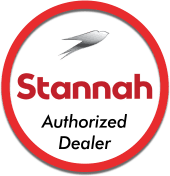
Stair lift Guide San Francisco
You want to stay in your home in the Bay Area right? Let our stair lifts help you out. There is a lot to understand and find out about stair lifts. We'll walk you through it. We've been installing them since 1987. That's a long time. Things have changed much in that time but at the end of the day, it's all about getting you upstairs safely, reliably and in style. I'll go through the stair lift parts, different types of stair cases, stairlifts, and options you have. First, we have to find out a few things:
- Stair lift Components
- What type of stairs do you have?
- Where are the stairs? (Inside or outside your home)
- What is the traffic like around the stairs?
- What are the dimensions of your stair case?
- What is going to fit on your stairs?
- WHY do you need the stair lift? Alright, let's jump into it.
Stair Lift Components
A stair lift is made up of three things: the rail, the carriage, and the seat.
The Stair Lift Rail
The rail is what get's mounted to the stair case first. It is either straight or curved (more on that later). It also holds the rack: a series of teeth that the gear on the stair lift "climbs" up or down the stairs. Here's a straight rail:
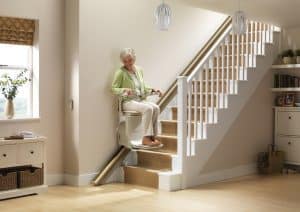
The rail is mounted to the stairs with feet which are typically attached with a lag (wood or concrete). Nothing is attached to the walls. It doesn't make any sense to do that as the walls can't hold as much weight as the stair treads. You can see the feet pretty well in this photo. I actually had to search more than a few gallery photos to find one that showed them well enough.
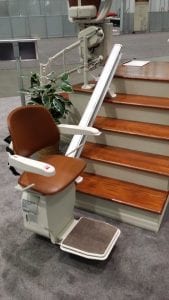
The wiring for the electrical also comes into the lift on the rail. The stair lift functions on battery power so if there is a loss of power to the house, the stair lift will keep on working.
THE CARRIAGE
This is the Carriage for a staight stair lift
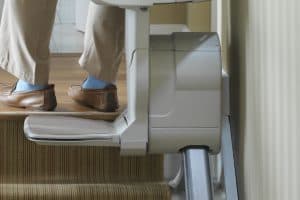
This is a carriage for a curved stair lift.
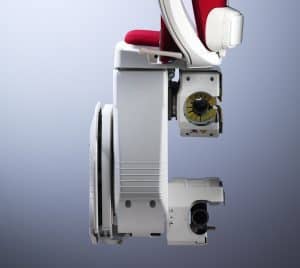
There are two rails on a curved stair lift versus just one on a straight.
The carriage is what houses the "brains and muscles" of the stair lift. The motor gearbox, electronics, safety switches (most) and the batteries are within the carriage. It's basically the hood of your car where the engine is kept. The motor gear box is within the carriage. The pinion attaches to the motor gearbox which climbs the rack on the rail. There is a printed circuit board which acts as the brain of the stair lift. It tells it when to start and stop based on the signals it is reading from the switches and circuits of the chair. The carriage also displays and LED troubleshooting that might have to occur. This allows us to diagnose problems over the phone and help get repairs and service completed faster.
THE SEAT
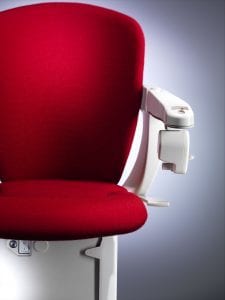
This is the fun part. The seat is where you sit but it is more than that on a stair chair lift. It's where you safely taken up the stairs.
The seat is very important. Comfort, performance, quality of materials, all of these matter. There are several seat options. We've talked about them down lower in this article so you can see that here.
Staircase Types
You either have a straight set of stairs or a curved set of stairs. It's that simple.
A straight staircase makes NO turns and has not platforms, or what is called an intermediate landing, like this:
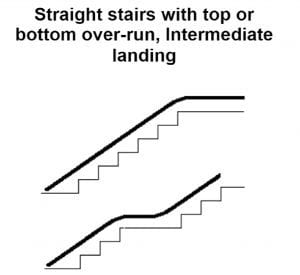
That's because a straight stair lift can only go on a stair case that has a relatively constant angle. The rails are mass made to reduce costs.
Staircase Location
Are your stairs outside or inside the home? Or both?
Yes, we can do outdoor stair lifts and indoor stair lifts. And we can provide straight and curved lifts on both steps.
Here's a link to our Curved Outdoor Stair Lift we finished recently.
Staircase Traffic
The house "traffic patterns" at the bottom, on, and at the top of the stair case are an extremely important factor in deciding on what solution is appropriate for your home.
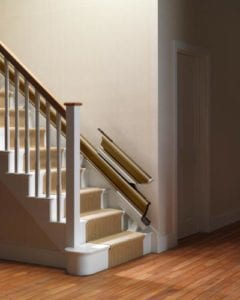
This is a retractable rail stair lift. It's only available on a STRAIGHT stair case. It automatically comes back up out of the way when the stair lift goes upstairs.
Why is that an option? Well, if the bottom of your stairs is very close or adjacent to a door, you'll need one. Many times it's used to allow the front door, garage door, or closet door to open.
However, there isn't an option for one on a curved stair case. It's just not possible. That's ok because we can curve the rail around corners on a curved rail.
Just remember that on a straight that the rail never turns.
Staircase Dimensions
We need to know the minimum width of your staircase. 29 inches or even 28 inches in width may work but anything less that is really, really tight. We want to make sure it is code compliant and safe.
Length of stair case really doesn't matter as we can just about do any length possible on a stair lift. The shortest you can go is about three steps. Anything less than that and you should just get a ramp, if possible.
Why do you need the Stair Lift?
There are many reasons why someone needs a stair lift but we need to know why.
Why do we need to know? Well, there are a lot of other factors involved in a stair lift that we can customize to make work for you.
For example, you may have bad knees but you may also have one arm that's stronger than the other. We can move the switch to the stronger hand.
Maybe the user can't keep themselves upright in the chair. We can provide a 5 point or a shoulder safety belt.

